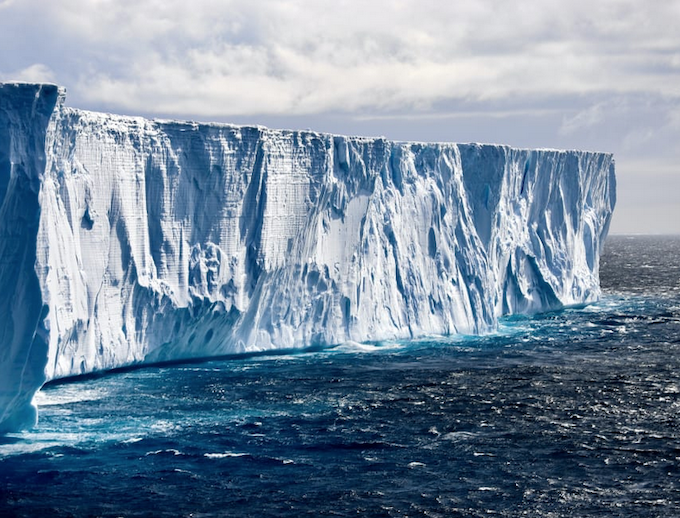
By Eloise Gibson, RNZ climate change correspondent
Scientists studying dramatic Antarctic sea ice loss have called for urgent reductions to greenhouse gases to keep the planet within liveable conditions.
Marine and ice specialists from top research outfits gathered at an emergency summit in Wellington today to discuss record low sea ice in Antarctica this year, which they described as “deeply alarming”.
“We are missing between seven and 10 New Zealands’ worth of sea ice”, National Institute of Water and Atmospheric Research (NIWA) marine physicist Dr Natalie Robinson said.
Not only were both the winter and summer areas of sea ice smaller than scientists have seen in all 44 years of satellite records, the recent lows were so far outside the normal range that it was difficult to even describe them using the normal statistical methods, she said.
More than 40 researchers banded together to release a joint statement saying the unprecedented Antarctic sea ice low was driven by warming of the Southern Ocean and atmosphere, and calling for urgent cuts to climate pollution.
Speaking to media afterwards, they were not buying the argument that New Zealand was too small to make a difference to climate change, saying urgent emissions cuts on the scale needed called for global cooperation and that New Zealand could have an outsized impact on a per-capita basis.
Although the group agreed there was still much to learn about the processes driving Antarctic sea ice, Dr Robinson feared the record lows could flow into another devastating year in 2024.
Similar pattern
“Personally that would be my expectation, if we end the winter season and enter the summer season with less sea ice, I would expect to see a similar pattern emerge next year.”
The group stopped short of declaring the sea ice at a tipping point of “new normal” lows, as has been suggested by some Australian researchers.

But there was plenty of cause for alarm without needing to use those words, NIWA principal scientist in marine physics Dr Craig Stevens said.
The role of the heating planet in shrinking the ice was agreed, but Stevens said there was much debate about the nuance and detail of the complex processes driving the sea ice, with scientists wanting a longer record than 44 years to make stronger conclusions on some points. They were having to speed up their work, because of the rapidity of the changes.
“We don’t all agree on all the nuances and details around this because there is still a lot of work to be done,” he said.
Both NIWA marine physicists talked about the personal toll of watching the changes in their careers, with Dr Stevens saying it kept him awake at night and Dr Robinson saying, “it’s hard to look at the future my children are going to experience, with full knowledge of the insufficiency of the action we are taking.
“We know what the problem is and what the solutions are and as individuals and communities we are looking in a different direction”.
New Zealand one of the closest nations
The Southern Ocean around the Antarctic continent plays a major role in regulating the climate — and as one of the closest nations to Antarctica, New Zealand’s climate was particularly strongly influenced, the group said.
At its seasonal peak, the typical area of ice floating on the Southern Ocean is so vast it doubles the size of the Antarctic continent, adding around 50 New Zealand’s worth of area.
That was why it has such far-reaching effects on the planet’s climate.
Sea ice supplies a habitat for penguins and allows algae to grow underneath, feeding marine life below.
The process of ice formation also directly sends carbon dioxide from the air into the ocean depths, as salty water that is separated from the freshwater ice sinks to the bottom carrying its carbon. Ice is also reflective of the sun’s heat.
“Sea ice keeps global climate system running the way we like it – it pulls heat out of atmosphere and into the deep ocean when it is formed, and mirrors energy back out to space,” Dr Robinson said.
“When that sea is not there almost all that energy will get absorbed by the dark ocean, because it is dark” heating the climate up.”

Ice area peak in 2014
For many years Antarctic sea ice was growing, even as Arctic sea ice shrank, with the Southern Ocean ice area hitting a peak in 2014.
Dr Robinson said the mystery was not so much why the Antarctic sea ice was shrinking now, as why it was able to resist global heating so long, considering how much the oceans were warming.
“They are fundamentally different systems . . . the Arctic is a basin contained by land masses, whereas at the other end of the globe we have a continent surrounded by ocean — the ocean completely circulates around the continent and helps keep the continent cool.
“Oceans have taken up almost all the extra heat that has been put into our climate system by human activities — and of that about 2/3 was taken up by the Southern Ocean on its own. The Southern Ocean is punching well above its weight in keeping climate as we like it.
“That heat taken up by Southern Ocean is perhaps catching up with sea ice processes.”
In 2022, the ice was at record lows.
Dramatic reduction
“But then we’ve had an even more dramatic reduction in this current year,” she said.
“That’s what brought us together to have this summit.”
“You would expect in a warmer ocean and stormier environment that sea ice would reduce, as it did in the Arctic, so the fact it hasn’t until now is the more surprising thing, that’s the thing we would like to understand”, Dr Robinson said.
“This has been an alarming drop off the cliff.”
She said researchers would like to believe it was just variability, but that seemed unlikely.
This article is republished under a community partnership agreement with RNZ.











































